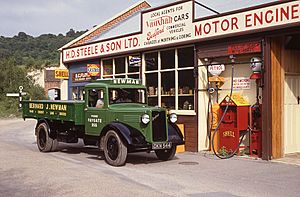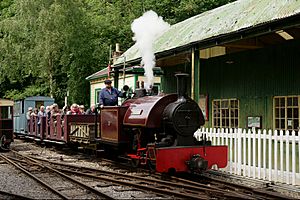- This page was last modified on 17 October 2025, at 10:18. Suggest an edit.
Amberley Museum & Heritage Centre facts for kids
Amberley Museum is a cool open-air museum in Amberley, England. It's near Arundel in West Sussex. This museum is all about showing how people used to work and live in the past. It's run by a charity called Amberley Museum and Heritage Centre.
The museum started in 1978. It used to be called Amberley Working Museum or Amberley Chalk Pits Museum. It's built inside old chalk quarries. For over 100 years, people dug out chalk here to make lime. You can still see some of the original lime kilns (big ovens) where they made lime. The museum also has lots of other old machines and displays. These include narrow-gauge railways, old buses, and many tools from different jobs.
Contents
Explore Amberley Museum's Location
This open-air museum covers a huge area, about 36 acres (146,000 square meters). It's right next to Amberley railway station. The museum focuses on the industrial history of South East England. It also shows how people communicated and traveled long ago.
The museum is set in an old chalk quarry. Here, chalk was turned into lime for building materials like mortar and cement. You can still see several kilns and old buildings. These include offices, a bagging shed, and a shed for locomotives.
There's also a quarry tunnel you can see. This tunnel was even used in a James Bond movie called A View to a Kill. Many other buildings have been moved to the museum or rebuilt there. New exhibition halls have also been added. You can even walk a nature trail to learn about the site's natural history and geology.
What to See: Museum Exhibits and Collections
The museum has many different exhibits and collections. Most of them are on display, but they might not always be working when you visit.
- Connected Earth is an exhibition about old telecommunications (how people talked over long distances).
- Electricity Hall shows how electricity was used in the past.
- Print Shop has old printing machines and tools. Volunteers often show how these machines work. They even print things for the museum!
- Machine Shop displays different tools used for working with metal. Some of these tools are still used to fix things at the museum.
- Wheelwright's Shop came from Horsham. A wheelwright is someone who makes and repairs wheels.
- Vintage Wireless and Communications is an exhibition about old radios and how people communicated. It also has an Amateur radio station.
- Ockenden's Ironmonger's Shop came from Littlehampton. An ironmonger sells metal tools and hardware.
- Timber Yard has old wood and a Steam crane for moving logs.
- Village Garage is a rebuilt automobile repair shop from the 1930s.
- Paviors Hall of Road Making is in an old iron building from Horsham. It shows how roads were built, from Roman times to today.
- Cycle Exhibition is also in the Paviors Hall. It shows different kinds of bicycles.
- Railway Hall displays engines and wagons from old narrow-gauge industrial railways.
- Billingshurst Signal Box is a rebuilt signal box. It used to control a railway crossing in Billingshurst.
- Contractors Monorail was used to move materials on building sites.
- Rural Telephone Exchange has 1940s telephone equipment from Coolham.
- Arundel Gin Building shows how people worked with lead and did plumbing.
- Brickyard Drying Shed is from the late 1800s and came from Petersfield, Hampshire.
- Fairmile Café is a 1930s roadside cafe that was moved here.
- Dover Cottage Pump House came from Arundel. It shows how water was pumped.
- Stationary Engine Shed and Municipal Engine House are from Littlehampton. They show big engines that stayed in one place.
- Fire Station is a new building, finished in 2008. It looks like a 1950s fire station. It has old fire engines and displays about firefighting in Sussex.
- Toll Bridge Hut came from a swing bridge in Littlehampton.
- Working Printing Workshop is where you can see printing in action.
- Cobbler's Shop has equipment from Bognor Regis. A cobbler repairs shoes.
- Hall of Tools has many tools and sometimes has demonstrations by experts.
Crafts and Skills You Can See
At the museum, you can often see people demonstrating old crafts. These include woodturning (shaping wood on a machine), making brooms, making walking sticks, and the work of a blacksmith (working with metal) and potters (making things from clay). The museum also holds special events regularly.
Trains and Buses: Collections on Wheels
Amberley's Narrow-Gauge Railway Collection
The Amberley Museum Railway is a special railway with tracks that are only 2 feet wide. It also has a railway exhibition hall. This part of the museum is all about British industrial narrow-gauge railways.
The museum has 45 locomotives (train engines). Five of these are steam-powered, 29 use internal combustion engines, and four are battery-electric. There are also about 80 items of rolling stock, mostly goods wagons. Many of these came from the old Brockham Museum. The collection includes railway items from the Dorking Greystone Lime Company and the Groudle Glen Railway on the Isle of Man. As of 2025, one of the five steam locomotives is working.
Southdown Bus Collection
The museum also has a rebuilt 1920s Southdown Bus garage. This garage is home to working buses. Most of these buses are from a local company called Southdown Motor Services. They are part of the Southdown Omnibus Trust collection.
On days when the museum is open, you can often take rides on these old Southdown buses. Here are some of the buses that are working:
- A 1914 Worthing Motor Services/Southdown Tilling Stevens open-top bus (IB 552). It's a bit fragile, so it's used carefully.
- A 1922 Southdown Leyland N Type open-top bus (CD 5125).
- A 1927 Southdown Dennis single-deck bus (UF 1517).
- A 1928 Sunderland Corporation Leyland Lion LT1 single-deck bus (BR 7132). This one is privately owned.
- A 1930 Southdown Tilling Stevens B10 A2 single-deck bus (UF 6805).
- Two 1931 Southdown Leyland Titan TD1 double-deck buses (UF 6473 and UF 7428).
- A 1937 Southdown Leyland Cub single-deck bus (ECD 524).
- A replica 1938 Shelvoke and Drewry Worthing Tramocar (BP9822) single-deck. This small bus is often used when fewer visitors are around.
More to Explore
- Arundel Museum and Heritage Centre
- List of British railway museums
- British narrow-gauge railways




